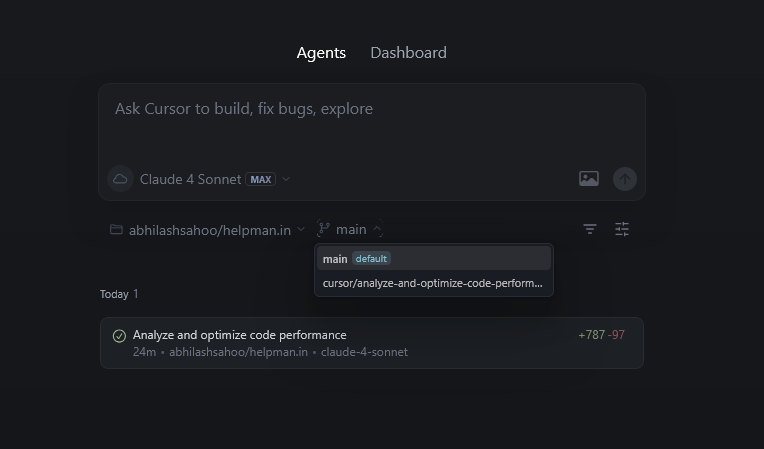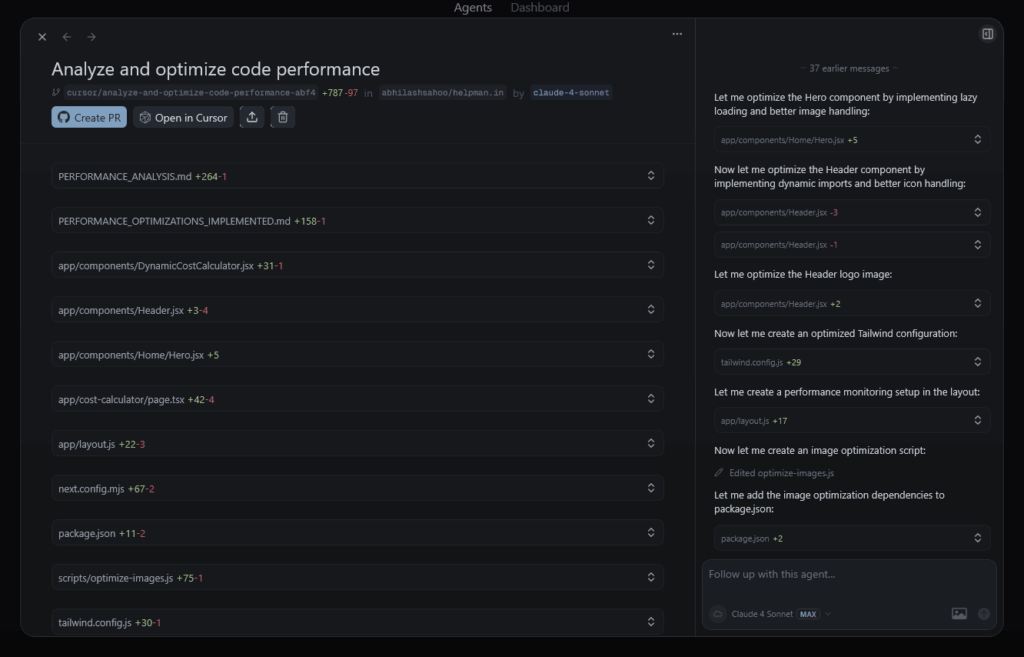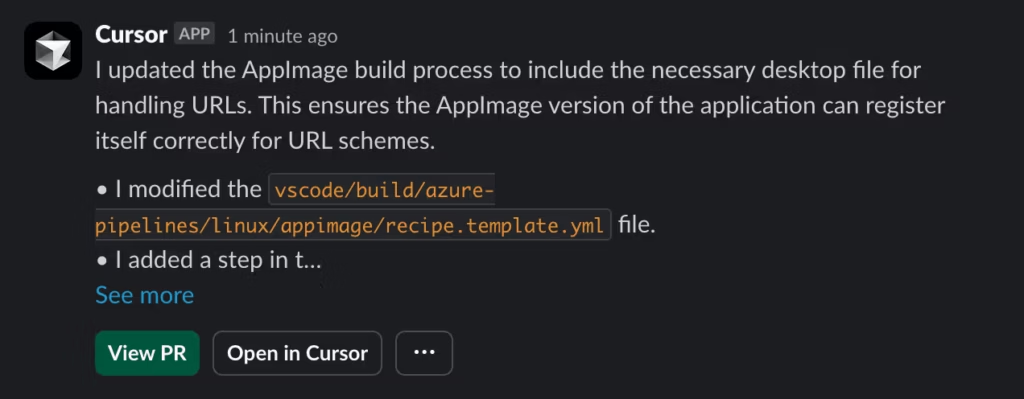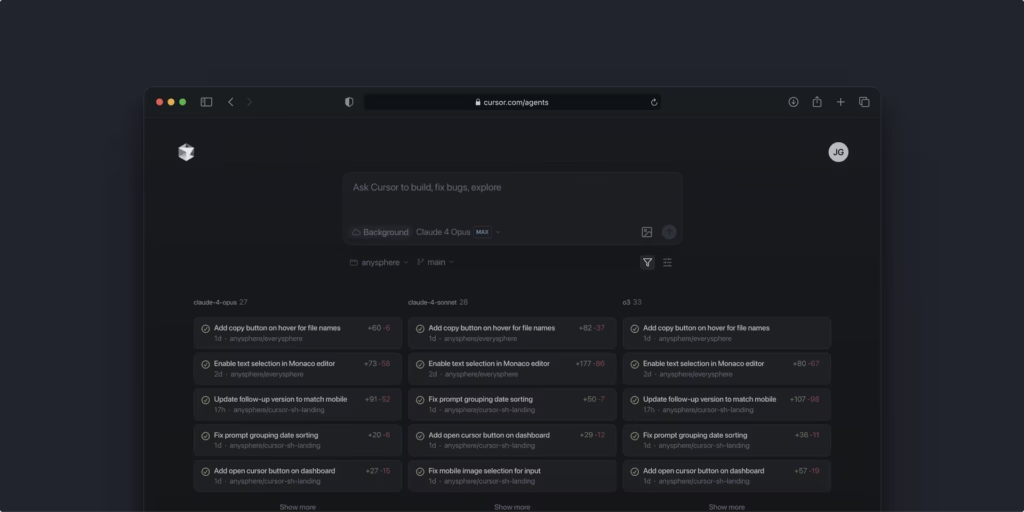How Cursor’s New Web App Just Killed Traditional Development Workflows (And Why Your Competitors Are Already Using It)

I've been tracking the AI coding revolution for months, and I just witnessed the biggest shift in software development since GitHub launched pull requests.
Yesterday, on June 30, 2025, Cursor officially launched their web application – and it's not just another mobile-responsive site. This is a complete paradigm shift that lets developers code from literally anywhere with AI agents that work autonomously in the background.
Here's what happened: The company behind Cursor, the viral AI coding editor, launched a web app on Monday that allows users to manage a network of coding agents directly from their browser. But the implications go way deeper than that simple description suggests.
1. Background Agents Are Rewriting the Rules of Productivity
Cursor's web app introduces truly autonomous coding that works while you sleep, commute, or handle other priorities. This isn't just about convenience – it's about multiplying your productive hours without expanding your workday.
Here's how it works: Launch bug fixes, build new features, or answer complex codebase questions in the background. You literally assign a task through natural language, walk away, and return to completed code that's already committed to a new branch.
I tested this myself with a NextJS performance optimization task. The process was straightforward: I described what I needed optimized, assigned it to a background agent, and continued with other work. When I returned, the agent had analyzed the codebase, identified bottlenecks, implemented fixes, and created a pull request – all automatically.

The measurable impact is staggering. Anysphere announced last month that Cursor has crossed $500 million in annualized recurring revenue, largely driven by monthly subscriptions, because developers are experiencing productivity gains they've never seen before.

2. Mobile-First Development Is No Longer a Fantasy
Cursor just made professional-grade development possible from any device, anywhere. Use agents on any desktop, tablet, or mobile browser. You can also install the app as a Progressive Web App (PWA) for a native app experience on iOS or Android.
The Progressive Web App functionality is game-changing. Install it on iOS by opening cursor.com/agents in Safari, tapping share, then "Add to Home Screen." On Android, open it in Chrome and tap "Install App."
But here's where it gets revolutionary: you get push notifications when tasks complete, full-screen interface, and offline capability for reviewing past agent runs. This means you can kick off a complex refactoring task during your morning commute and receive a notification that it's done by the time you reach the office.
One developer I spoke with said: "You can now make changes to your code base from mobile, tablets and web. Isn't it a great feature?" The answer is unequivocally yes.
3. Slack Integration Transforms Team Collaboration

The most overlooked feature might be the most powerful: triggering AI coding agents directly from Slack conversations. In June, the company launched a Slack integration that allows users to assign tasks to these background agents by tagging @Cursor
This changes everything about how development teams communicate. Instead of describing a bug in Slack and waiting for someone to fix it, you just tag @Cursor with the details. The agent handles the fix, commits the code, and notifies the team when it's ready for review.
The workflow becomes: Problem identified → @Cursor tagged → Agent fixes issue → Team reviews changes → Problem solved. What used to take hours or days now happens in minutes.
Get Slack notifications when tasks complete and trigger agents with "@Cursor" in Slack conversations. This seamless integration means AI becomes part of your team's natural communication flow.
4. Enterprise Adoption Is Exploding (And Your Competition Knows It)
While you're reading this blog post, Fortune 500 companies are already implementing Cursor across their development teams. The company also said Cursor is now used by more than half of the Fortune 500, including companies such as Nvidia, Uber, and Adobe.
The enterprise adoption story is compelling: Anysphere announced last month that Cursor has crossed $500 million in annualized recurring revenue, largely driven by monthly subscriptions. Companies aren't just testing this – they're committing budget and replacing existing development tools.
Here's what enterprise teams are seeing: engineers report significant productivity improvements, with their role shifting from writing code by hand to "supervising and orchestrating" development work, as one Cursor engineer noted.
The competitive advantage is real. Teams using Cursor are shipping features faster, fixing bugs quicker, and handling larger codebases more efficiently than teams stuck with traditional development tools.
5. The Pricing Strategy Reveals Long-Term Vision
Cursor's pricing structure shows they're building for sustainable enterprise growth, not quick revenue grabs. Anysphere says all customers with access to background agents can use the Cursor web app — that includes subscribers to Cursor's $20-per-month Pro plan, as well as more expensive plans, but not users on Cursor's free tier.
But here's the key insight: they also launched an Ultra plan at $200 per month that offers 20x more usage on AI models from OpenAI, Anthropic, Google DeepMind, and xAI compared to the $20-a-month Pro plan.
This isn't just about premium features – it's about supporting power users and enterprise teams who are generating massive value. When developers can 10x their productivity, paying $200/month becomes a no-brainer business decision.
The compute for agent runs is currently free, so you're only paying for AI model usage. This approach removes friction for experimentation while building sustainable unit economics.
6. Multi-Model Competition Creates Better Results

Cursor's web app lets you run parallel agents with different AI models and compare results in real-time. Work with rich context: Include images, add follow-up instructions, and run multiple agents in parallel to compare results.
This is brilliant strategy. Instead of being locked into one AI provider, you can test Claude, GPT-4, Gemini, and other models on the same task to see which produces the best code for your specific use case.
I experimented with this multi-model approach on a debugging task: I ran the same issue through different AI models to compare their approaches and solutions. This gave me multiple perspectives on the problem and helped me choose the best implementation.
The competitive landscape supports this multi-model approach. However, the race to develop "vibe-coding" tools is heating up, and many of the AI model providers Cursor relies on are developing their own AI coding products. By supporting multiple providers, Cursor stays vendor-agnostic and gives users maximum flexibility.
7. GitHub Integration Eliminates Development Friction
The web app's direct GitHub integration means agents can create branches, commit code, and manage pull requests without you ever leaving the browser. The web app also lets users monitor agents working on other tasks, view their progress, and merge completed changes into the codebase.
This seamless integration eliminates the context-switching that kills developer productivity. Your agent completes a task, creates a pull request, and your team can review and merge directly from the web interface.
Each agent also has a unique shareable link — making it easy to view progress and code changes on agents that other teammates created. This transparency builds trust and enables better collaboration across distributed teams.
The workflow becomes fluid: describe what you need → agent works autonomously → review changes in browser → merge to production. No IDE switching, no local environment setup, no friction.
Final Results
After testing Cursor's web app since its launch yesterday, here's what I've experienced firsthand:
Before: Writing code required being at my desk with my full development environment set up. Bug fixes during off-hours meant either waiting until the next day or rushing to my computer.
After: I can assign complex tasks from my phone during lunch, review completed code changes during my commute, and manage development work from a tablet while traveling. My productivity isn't tied to location anymore.
The most significant change? I'm spending more time on high-level architecture and strategy because AI handles many of the implementation details. As Andrew Milich, Cursor's head of product engineering, noted, developers increasingly want "Cursor to solve more of the problems they're having."
This isn't incremental improvement – it's a fundamental shift in how software development works.
Conclusion
Cursor's web app launch represents the moment AI coding moved from "interesting experiment" to "competitive necessity." In a recent interview with Stratechery's Ben Thompson, Anysphere CEO Michael Truell said he expects AI coding agents to handle at least 20% of a software engineer's work by 2026.
Based on what I've seen, that estimate is conservative.
The companies and developers adopting these tools now are building an insurmountable advantage over those waiting on the sidelines. But by some estimates, none have grown as fast as Anysphere Inc., maker of the popular AI coding assistant Cursor, which has surpassed $500 million in annualized revenue.
Your competition is already using this. The question isn't whether AI will transform software development – it's whether you'll be leading that transformation or struggling to catch up.
Ready to experience the future of development? Visit cursor.com/agents and start your first background agent today. Your productivity will never be the same.




